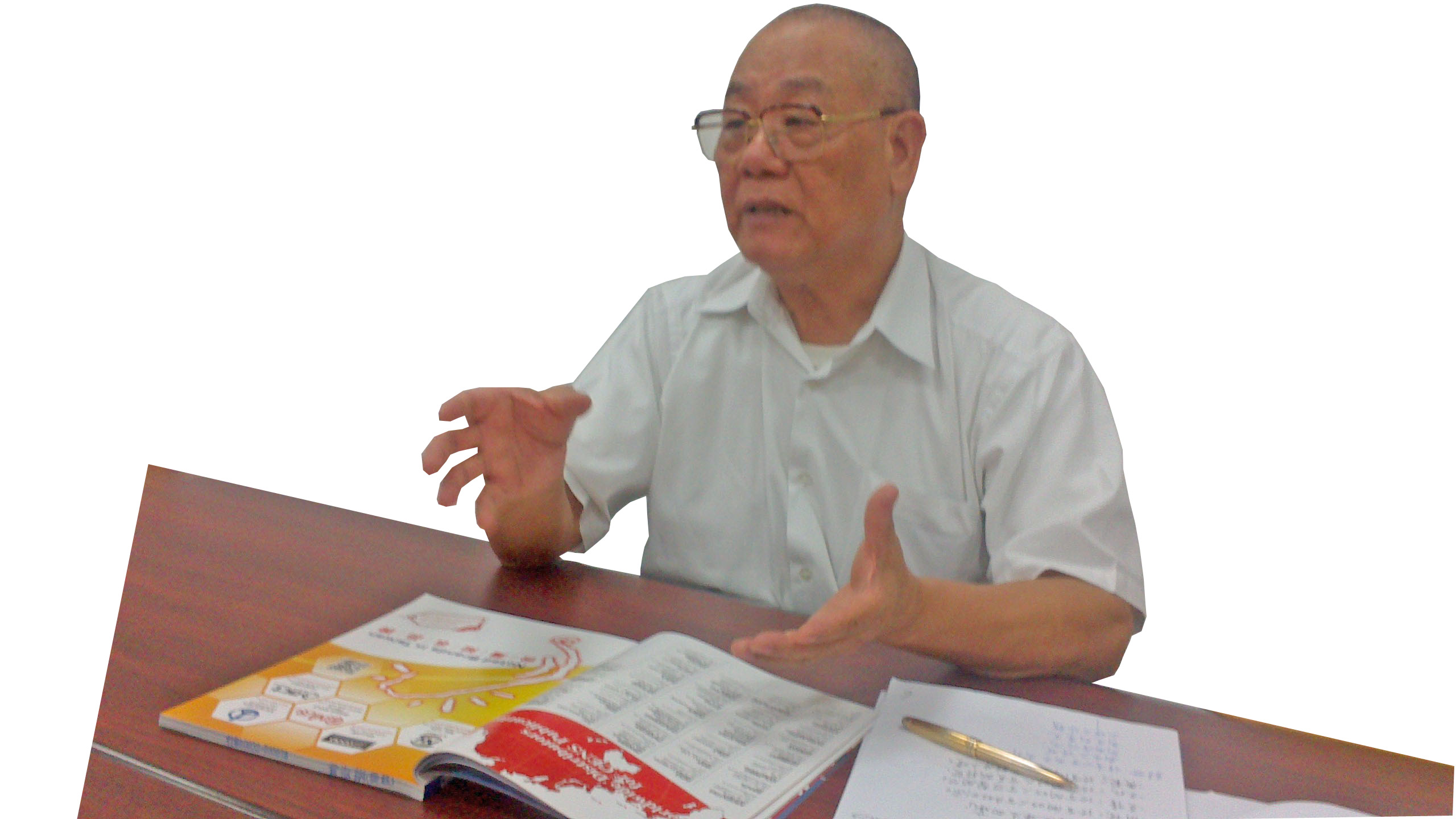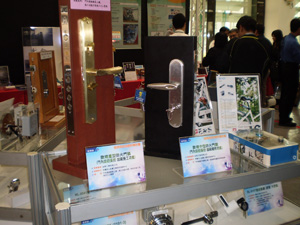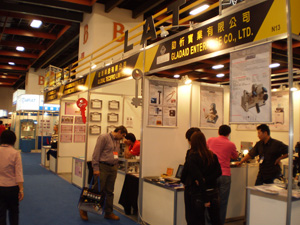LAT Chairman Talks as Insider of Taiwan's Lock Industry
Industry growth racked by unscrupulous operators selling counterfeits
2013/09/03 | By Steve Chuang
Taiwan's lock industry dates back to the 1950s, when a few manufacturers in Pingtung and Chiayi Counties likely used antiquated tools to hammer out locks and components. The state of the sector has evolved significantly after some 60 years, with most operators able to match advanced rivals technologically and qualitatively outdo emerging competitors, also enjoying robust growth in exports.
Interviewed by CENS, Ho says that the industry supplies a wide range of traditional locks as door locks, cylinder locks, padlocks, anti-theft locks for cars and motorcycles, cabinet locks, cam locks, furniture locks, mortise locksets, desk locks, etc., as well as higher-end locks integrated with advanced security technologies as electronic locks, IC card locks, infrared remote deadbolt locks, IRIS recognition solutions and biometric door locks.
The local industry has 300-400 makers mostly modestly sized and concentrated on OEM (original equipment manufacturing) and ODM (original design manufacturing). Exports total NT$50-60 billion yearly but the total output is likely much higher, as most makers fill downstream orders, for furniture, automotive suppliers who then export finished products worldwide. The total annual output likely reaches several hundred billion New Taiwan dollars, says Ho.
Only 20-30 makers export independently, with door locks, padlocks of copper, alloy and stainless steel, cam locks, cabinet locks and motorcycle and bicycle locks as major items ranging from low to high end, and mainly shipped to Japan, Europe, the U.S., Australia, Southeastern Asia, Africa and Latin America.
Challenges
Amid increasingly competitive global market and uncertain global economy, Ho opines that the industry faces ever more challenges as most traditional manufacturing looks for sustainable development as they transform.
Taiwanese makers must try to invest more in R&D to enhance product quality, functionality and security characteristics, so as to build capability and profile to earn buyers' trust that their locks can truly protect users' property and safety, says Ho. Unfortunately a perennial problem remains that most operators lack enough resources to invest in R&D, hence diminishing their competitiveness in ever-changing markets.
Operators have to break with tradition to develop more unique products by tapping core skills and pursuing new knowledge and innovation. One way to innovation is to apply advanced technologies like information technology and biometrics, also via partnering with R&D labs and other sectors, which will help Taiwanese makers to better compete globally against underselling rivals in increasingly demanding markets, says Ho.

Age-old problem
Another exigent problem Ho sees is copycatting that is rampant in Taiwan's domestic market, undermining industry and market development. Locks sold globally are classified into five security-strength-based grades, but some local retailers import counterfeits to sell at lower prices with deceptive data on security grades and origin of product, says Ho.
The problem is the lack of clear and definite rules on protection of intellectual property and sound certification programs for security grades and origin of product. Over 10,000 lock retailers and locksmiths along with hundreds of makers in Taiwan make for a fragmented market, whose survival is often hand-to-mouth that simply does not breed any notion of coexistence, instead cultivating vicious rivalry via underselling using non-certified counterfeits. So in the long-run, high-quality and certified products are sidelined to discourage suppliers who spend considerable resources on R&D every year to also compromise consumers' interest, according to Ho.
Objectives
Therefore the LAT will continue to aid operators to acquire R&D resources from the government and tap synergies with academia and local research institutes, and will also try to establish market rules in cooperation with the government by pushing for certification of lock security grades, qualified locksmiths and origin of product, as well as enforcement of intellectual property laws, coupled with more international exchanges with lock associations overseas.
An encouraging example of cross-industry cooperation is the development of the EN12320 Grade 5 padlock, achieved with technological support from the Metal Industries Research & Development Center (MIRDC), a local R&D body, which is the type of synergy the association has been pursuing, says Ho.
As for certifying security grades, Ho notes that the association has been working on specifying criteria by referring to those established in developed countries in collaboration with the Bureau of Standard, Metrology and Inspection and experts from the MIRDC, to work out domestically developed certification mechanisms in line with standards established in the U.S. and Europe and global market trends, as well as certification mark to identify security grades and product origin.
Ho emphasizes that such criteria have been developed since the association was founded but will take more years to complete due to considerable research paper and paperwork, with the criteria being required to apply to different lock models. The criteria and certification mark can better help manufacturers and retailers to achieve market segmentation and transparent pricing to keep standard-compliant, certified locks from being copied to offer quality products to users. Moreover this mechanism enables Taiwanese makers to cut cost on overseas certification as they do at present, also adding value and credibility to products to attract foreign buyers.
Qualifying local locksmiths is also one of Ho's objectives. So the LAT has enhanced exchanges with locksmith associations worldwide, including Associated Locksmiths of America, The Co-operative Association of Japan Lock Security, European Locksmith Federation and Master Locksmiths Association, also having negotiated with the government for support over the past years. The LAT is supported by the Ministry of the Interior to offer education and examination for locksmiths. In the future, Taiwanese locksmiths will not be allowed to practice their trade until having been trained for a specified duration and passed exams on know-how and professional ethics, notes Ho.

Branding
Ho believes strongly in the benefits of branding, which is key to ensuring profitability and sustainable development. A few years ago when he was made the LAT chairman, Ho cited a report in BusinessWeek indicating that the world's top 100 brands generate US$228 billion in profits a year, almost 60 times that scored by the biggest 100 OEMs. Such stark contrast is worsened by the backwardness amid most Taiwanese OBMs (original brand manufacturer), who generally can't even come up with a catchy, easily-remembered, westernized, original product label.
Not one brand has been established in Greater China for over 60 years so far because of the “Chinese mindset,” says Ho, who has always believed in a brand's cohesive force to bind owners and employees with shared mission to cultivate positive organizational culture, hence encouraging responsible behavior to minimize ego-tripping, counter-productive envy and infighting to build long-term growth that results in improved life quality for all.
Ho is confident of Taiwanese lock makers' strong potential to develop brands, mainly due to their consummate production capability. Taiwan's lock industry is especially versed at developing and making blade cylinders, pin tumbler cylinders, tubuler cylinders, Kaba cylinders, and disc cylinders using advanced manufacturing equipment. The industry is also able to apply stainless steel, cold steel, cooper, alloy, zinc, aluminum, to roll out mid-to-high-end locks and customized models with tension-resistant structure, high impact and corrosion resistance, dustproof, bulletproof features for special purposes, according to Ho.
Taiwanese makers should be more confident to stand tall. They need to find ways to brand and market products strategically and intelligently. Creating products that are not just functionally excellent but unique along with market-savvy strategies is the best way to strengthen brand image and value, says Ho.
Locks are products needing high technology, security and dedication from manufacturers, and will always be in demand globally, concludes Ho.




